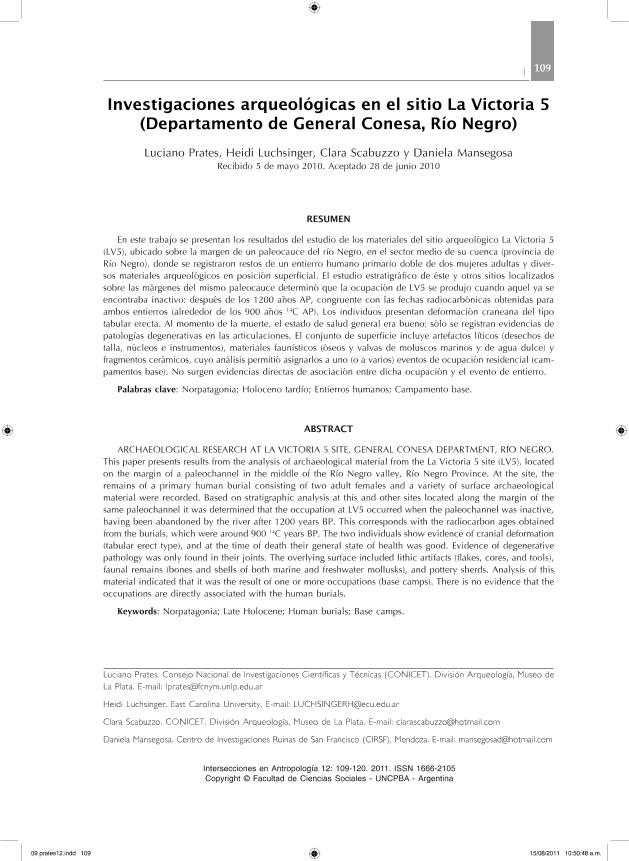Artículo
En este trabajo se presentan los resultados del estudio de los materiales del sitio arqueológico La Victoria 5 (LV5), ubicado sobre la margen de un paleocauce del río Negro, en el sector medio de su cuenca (provincia de Río Negro), donde se registraron restos de un entierro humano primario doble de dos mujeres adultas y diversos materiales arqueológicos en posición superficial. El estudio estratigráfico de éste y otros sitios localizados sobre las márgenes del mismo paleocauce determinó que la ocupación de LV5 se produjo cuando aquel ya se encontraba inactivo: después de los 1200 años AP, congruente con las fechas radiocarbónicas obtenidas para ambos entierros (alrededor de los 900 años 14C AP). Los individuos presentan deformación craneana del tipo tabular erecta. Al momento de la muerte, el estado de salud general era bueno; sólo se registran evidencias de patologías degenerativas en las articulaciones. El conjunto de superficie incluye artefactos líticos (desechos de talla, núcleos e instrumentos), materiales faunísticos (óseos y valvas de moluscos marinos y de agua dulce) y fragmentos cerámicos, cuyo análisis permitió asignarlos a uno (o a varios) eventos de ocupación residencial (campamentos base). No surgen evidencias directas de asociación entre dicha ocupación y el evento de entierro. This paper presents the results from the analysis of archaeological material from the La Victoria 5 site (LV5) which is located on the margin of a paleochannel in the middle valley of the Río Negro (Río Negro province). At this site, the remains of a primary human burial consisting of two adult females and a variety of archaeological material on the surface were recorded. Based on stratigraphic analysis of this and , in addition to other sites located along the margin of the same paleochannel, it has been determined that the occupation at LV5 occurred when the paleochannel was inactive and abandoned by the river after 1,200 years BP. This corresponds with the radiocarbon ages obtained from the burials which were around 900 14C years BP. The two individuals show evidence of cranial deformation (tabular erect tipe) and at the time of death, the general state of health was good. Only evidence of degenerative pathology was found in the joints. The overlying surface included lithic artifacts (flakes, cores, and tools), faunal remains (bones and shells of both marine and freshwater mollusks) and pottery sherds. Analysis of this material indicated that this material was the result of one (or various) occupations (base camps) and there is no evidence that they are in direct association with the human burials.
Investigaciones arqueológicas en el sitio La Victoria 5 (Departamento de General Conesa, Río Negro)
Título:
Archaeological research at la Victoria 5 site, General Conesa Department, Río Negro
Fecha de publicación:
08/2011
Editorial:
Universidad Nacional del Centro de la Provincia de Buenos Aires. Facultad de Ciencias Sociales
Revista:
Intersecciones en Antropología
ISSN:
1666-2105
Idioma:
Español
Tipo de recurso:
Artículo publicado
Clasificación temática:
Resumen
Palabras clave:
Norpatagonia
,
Holoceno tardío
,
Entierros humanos
,
Campamento base
Archivos asociados
Licencia
Identificadores
Colecciones
Articulos(CCT - LA PLATA)
Articulos de CTRO.CIENTIFICO TECNOL.CONICET - LA PLATA
Articulos de CTRO.CIENTIFICO TECNOL.CONICET - LA PLATA
Citación
Prates, Luciano Raúl; Luchsinger, Heidi; Scabuzzo, Clara; Mansegosa, Daniela Alit; Investigaciones arqueológicas en el sitio La Victoria 5 (Departamento de General Conesa, Río Negro); Universidad Nacional del Centro de la Provincia de Buenos Aires. Facultad de Ciencias Sociales; Intersecciones en Antropología; 12; 1; 8-2011; 109-120
Compartir




